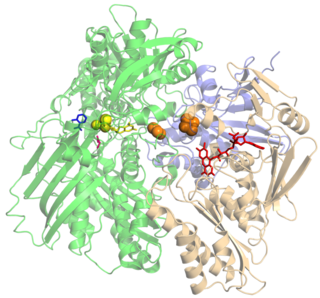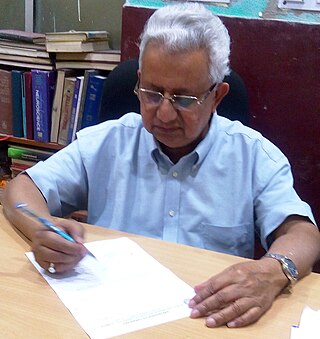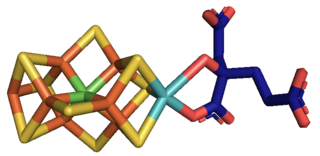Related Research Articles

Molybdenum is a chemical element with the symbol Mo and atomic number 42 which is located in period 5 and group 6. The name is from Neo-Latin molybdaenum, which is based on Ancient Greek Μόλυβδος molybdos, meaning lead, since its ores were confused with lead ores. Molybdenum minerals have been known throughout history, but the element was discovered in 1778 by Carl Wilhelm Scheele. The metal was first isolated in 1781 by Peter Jacob Hjelm.

Xanthine oxidase is a form of xanthine oxidoreductase, a type of enzyme that generates reactive oxygen species. These enzymes catalyze the oxidation of hypoxanthine to xanthine and can further catalyze the oxidation of xanthine to uric acid. These enzymes play an important role in the catabolism of purines in some species, including humans.
A prosthetic group is the non-amino acid component that is part of the structure of the heteroproteins or conjugated proteins, being tightly linked to the apoprotein.
Bioinorganic chemistry is a field that examines the role of metals in biology. Bioinorganic chemistry includes the study of both natural phenomena such as the behavior of metalloproteins as well as artificially introduced metals, including those that are non-essential, in medicine and toxicology. Many biological processes such as respiration depend upon molecules that fall within the realm of inorganic chemistry. The discipline also includes the study of inorganic models or mimics that imitate the behaviour of metalloproteins.

Molybdopterins are a class of cofactors found in most molybdenum-containing and all tungsten-containing enzymes. Synonyms for molybdopterin are: MPT and pyranopterin-dithiolate. The nomenclature for this biomolecule can be confusing: Molybdopterin itself contains no molybdenum; rather, this is the name of the ligand that will bind the active metal. After molybdopterin is eventually complexed with molybdenum, the complete ligand is usually called molybdenum cofactor.

Sulfite oxidase is an enzyme in the mitochondria of all eukaryotes, with exception of the yeasts. It oxidizes sulfite to sulfate and, via cytochrome c, transfers the electrons produced to the electron transport chain, allowing generation of ATP in oxidative phosphorylation. This is the last step in the metabolism of sulfur-containing compounds and the sulfate is excreted.

Nitrate reductases are molybdoenzymes that reduce nitrate to nitrite. This reaction is critical for the production of protein in most crop plants, as nitrate is the predominant source of nitrogen in fertilized soils.

Aldehyde oxidase (AO) is a metabolizing enzyme, located in the cytosolic compartment of tissues in many organisms. AO catalyzes the oxidation of aldehydes into carboxylic acid, and in addition, catalyzes the hydroxylation of some heterocycles. It can also catalyze the oxidation of both cytochrome P450 (CYP450) and monoamine oxidase (MAO) intermediate products. AO plays an important role in the metabolism of several drugs.
Nitrate reductase (NADPH) (EC 1.7.1.3, assimilatory nitrate reductase, assimilatory reduced nicotinamide adenine dinucleotide phosphate-nitrate reductase, NADPH-nitrate reductase, assimilatory NADPH-nitrate reductase, triphosphopyridine nucleotide-nitrate reductase, NADPH:nitrate reductase, nitrate reductase (NADPH2), NADPH2:nitrate oxidoreductase) is an enzyme with systematic name nitrite:NADP+ oxidoreductase. This enzyme catalises the following chemical reaction
Trimethylamine N-oxide reductase is a microbial enzyme that can reduce trimethylamine N-oxide (TMAO) into trimethylamine (TMA), as part of the electron transport chain. The enzyme has been purified from E. coli and the photosynthetic bacteria Roseobacter denitrificans.
In enzymology, a 4-oxoproline reductase (EC 1.1.1.104) is an enzyme that catalyzes the chemical reaction
Arsenate reductase (azurin) (EC 1.20.9.1) is an enzyme that catalyzes the chemical reaction

In enzymology, a pyrroline-5-carboxylate reductase (EC 1.5.1.2) is an enzyme that catalyzes the chemical reaction

JoAnne Stubbe is an American chemist best known for her work on ribonucleotide reductases, for which she was awarded the National Medal of Science in 2009. In 2017, she retired as a Professor of Chemistry and Biology at the Massachusetts Institute of Technology.
Bernt Krebs is a German scientist. He is conducting research at the Faculty of Chemistry, University of Münster.
The aldehyde oxidase and xanthine dehydrogenase, a/b hammerhead domain is an evolutionary conserved protein domain.
Molybdenum cofactor sulfurtransferase (EC 2.8.1.9, molybdenum cofactor sulfurase, ABA3, MoCo sulfurase, MoCo sulfurtransferase) is an enzyme with systematic name L-cysteine:molybdenum cofactor sulfurtransferase. This enzyme catalyses the following chemical reaction

In enzymology, an aldehyde ferredoxin oxidoreductase (EC 1.2.7.5) is an enzyme that catalyzes the chemical reaction

Sabyasachi Sarkar is an Indian chemist. He has worked with functional models related to hyperthermophilic to mesophilic metalloproteins enriching bioinorganic chemistry. A Replica of a Fishy Enzyme and the reduced xanthine oxidase also have been made. Inhibition patterns in the Michaelis complex of low molecular weight hepatic sulfite oxidase model complex have been exhibited. Based on functional mimicking of a series of molybdoenzymes he showed that the even in model enzymatic oxotransfer reactions the participation of similar enzyme-susbrate (E-S) complex is a real entity. Such a chemical spices (E-S) responds to spontaneous intramolecular oxidative addition and reductive elimination to complete the oxotransfer reaction. Such a reaction differs from conventional chemical oxotransfer reaction where the reaction between the starting reactants happens in Eyring activated complex. He demonstrated that carbon dioxide molecule does bind to magnesium in chlorophyll in photosynthesis as proposed by R. M. Willstätter one-hundred years ago and modeled hydrogenase captioned as better than nature. The rare reaction of a Cu(II) complex with aerial oxygen to generate superoxide anion and Cu(III) has been shown addressing the native SOD reaction. Similarly the aspect of copper-molybdenum antagonism in ruminant animals have been investigated. His research has shown the architectural marvel in silk cocoon with the natural thermostatic and humidity control with preferential oxygen gating inside cocoon as green house architecture. He proposed a new magneto reception mechanism for nocturnal moth in sensing the Earth's magnetic field to navigate with a stable pool of carbon-centric free radicals along with ferromagnetic components. He extended the work on nano carbon and developed cheap sources of water soluble nano carbon including naturally formed graphene oxide from low grade coal. These are used in the growth of young plants as promoters to slowly release micro nutrients and adsorbed water. He explored these to explore bio-imaging and demonstrating that non-toxic carbon nano onion can cross blood–brain barrier to carry drug as cargo and can be effectively be excreted from the body. The utility of such nano carbon to control mosquito breeding in preventing mosquito vectors of infectious diseaes and the use of reduced graphene oxide to prevent hospital pathogens have been demonstrated. On the environment aspect the presence of damaged floating carbon nano tubes in aerosols is shown to contribute global warming, winter smog and elevating breathing problem. He demonstrated the adverse effect of soap and detergent discharge near tube wells in releasing arsenic and fluoride contaminated water. He also mapped the degradation of a heritage monument, the Taj Mahal.

Molybdenum is an essential element in most organisms. It is most notably present in nitrogenase which is an essential part of nitrogen fixation
References
- ↑
- Stephen J. Lippard, Jeremy M. Berg, Principles of Bioinorganic Chemistry, University Science Books, 1994, ISBN 0-935702-72-5, pg 318